Introduction
Customer retention in SaaS refers to the ability to maintain a loyal customer base over time by encouraging ongoing subscription renewals. The SaaS model depends on recurring revenue, where long-term customer relationships contribute significantly to profitability. Studies have shown that increasing customer retention by just 5% can boost profits by 25% to 95%, making retention a more cost-effective and impactful strategy compared to customer acquisition.
In a typical SaaS business, the Customer Acquisition Cost (CAC) ranges between $200 and $1,000 per customer, depending on the product and target market. However, the cost to retain an existing customer is often 5 to 7 times lower, emphasizing the financial importance of customer retention. Moreover, SaaS companies often realize the majority of a customer’s value after 12 to 18 months, highlighting the need to retain users long enough to reach profitability.
The Importance of Customer Retention
In the SaaS world, customer retention is not just beneficial; it is essential. Here’s why:
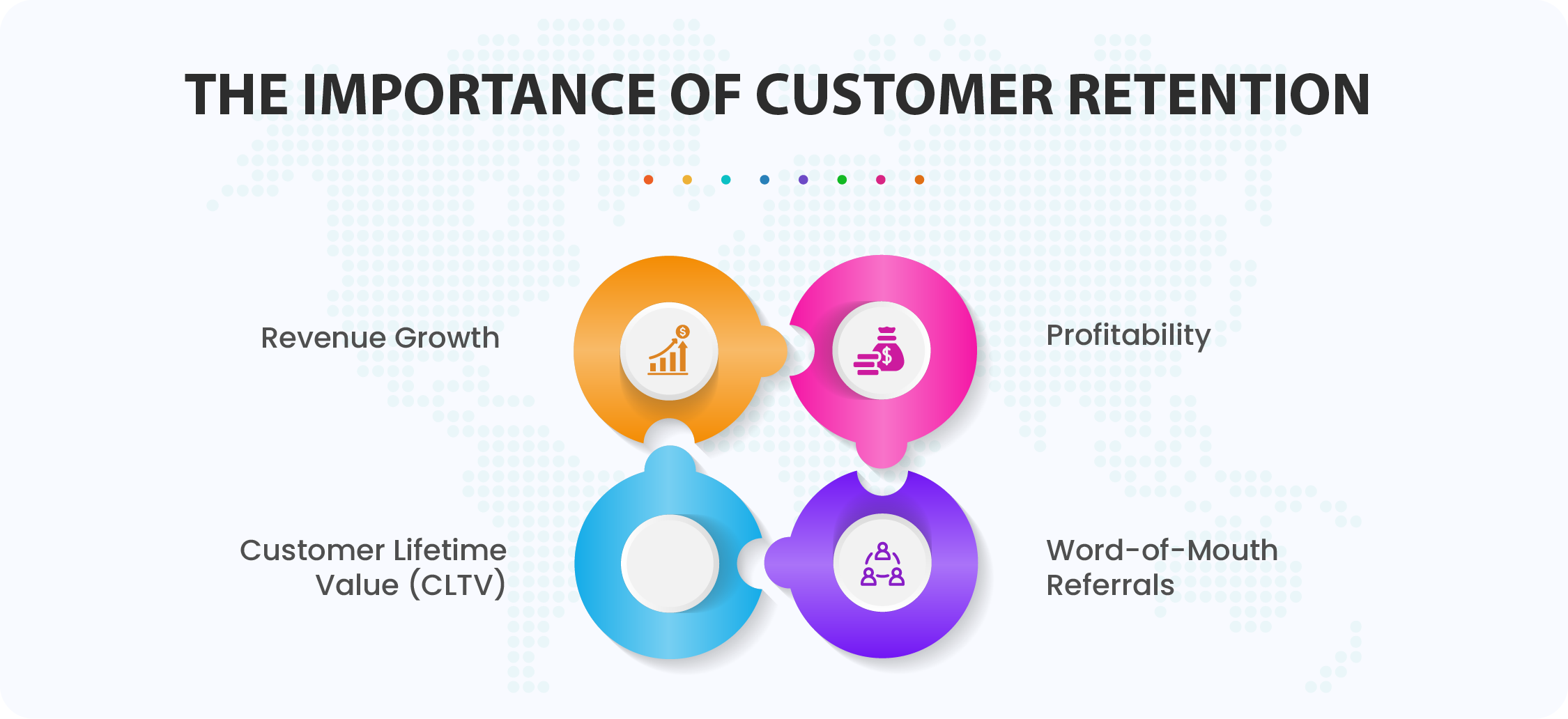
- Revenue Growth: A loyal customer base ensures predictable revenue, which is crucial for long-term financial stability and growth. Retention directly impacts metrics like Monthly Recurring Revenue (MRR) and Annual Recurring Revenue (ARR).
- Profitability: Retaining existing customers is significantly more cost-effective than acquiring new ones. According to industry studies, acquiring a new customer can cost five to seven times more than retaining an existing one.
- Customer Lifetime Value (CLTV): Retention drives CLTV, a key metric in SaaS businesses that reflects the total revenue a company can expect from a customer throughout their relationship. A high CLTV-to-CAC (Customer Acquisition Cost) ratio indicates a healthy and profitable business.
- Word-of-Mouth Referrals: Happy, long-term customers often become brand advocates, spreading positive reviews and driving organic growth through referrals. This reduces marketing expenditure and enhances brand reputation.
Retention ensures that SaaS companies maximize the value they derive from their existing customer base, creating a sustainable business model that supports expansion and innovation.
Understanding Customer Churn in SaaS
Customer churn is a critical metric for SaaS businesses, reflecting the rate at which customers stop using a product or cancel their subscriptions. As SaaS companies rely on recurring revenue models, churn directly impacts revenue growth, profitability, and overall business sustainability. Understanding the nuances of churn is essential for developing effective strategies to reduce it.
What is Churn?
Churn rate measures the percentage of customers or revenue lost during a specific period. It is calculated using the formula:
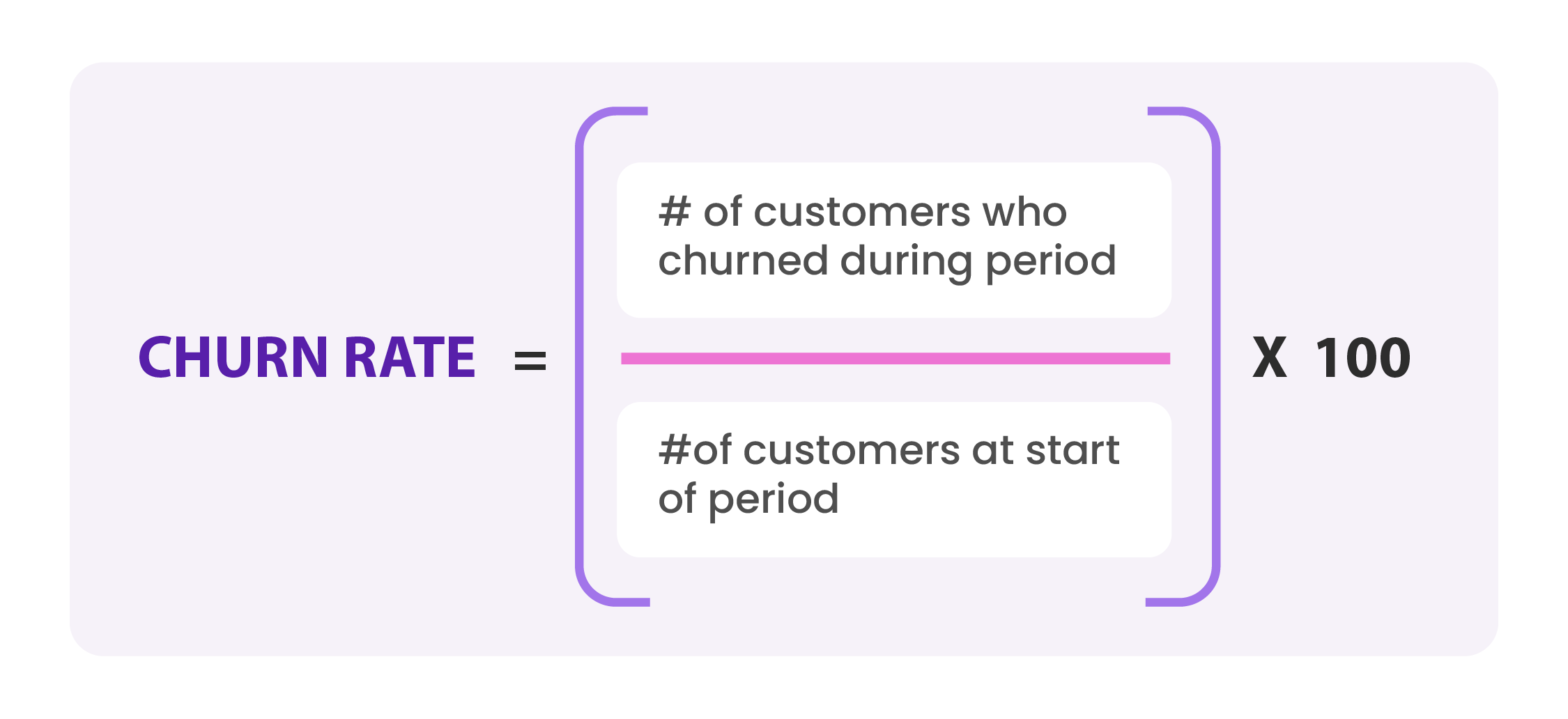
For revenue churn, the formula focuses on recurring revenue lost instead of customer numbers.
Impact of Churn on SaaS Businesses
- Revenue Loss: High churn erodes Monthly Recurring Revenue (MRR) and Annual Recurring Revenue (ARR), making it challenging to achieve net growth. For example, a SaaS business with $50,000 MRR and a 5% monthly churn rate loses $2,500 per month, or $30,000 annually.
- Reduced Customer Lifetime Value (CLV): Churn shortens the duration a customer remains subscribed, reducing their overall value to the business. For instance, a customer paying $100/month with a churn rate of 5% monthly has an average lifetime of only 20 months, resulting in a CLV of $2,000.
- Increased Acquisition Pressure: To maintain revenue, businesses must constantly replace lost customers, leading to higher Customer Acquisition Costs (CAC). Acquiring new customers is often 5 to 7 times more expensive than retaining existing ones.
- Brand Reputation and Growth Stagnation: A high churn rate can signal dissatisfaction, harming the brand’s reputation and slowing growth, as dissatisfied customers may share negative feedback.
Types of Churns
1. Voluntary Churn
Voluntary churn occurs when customers actively cancel their subscriptions due to dissatisfaction, unmet needs, or changing priorities. Common reasons include a perceived lack of value, poor user experience or usability issues, and switching to a competitor’s offering. For example, a customer might switch from one project management tool to another due to more robust features offered by the competitor.
2. Involuntary Churn
Involuntary churn happens unintentionally, often due to billing issues such as expired credit cards, failed payment processing, or technical errors in the billing system. While it may seem unavoidable, proactive measures like automated payment reminders can help reduce its occurrence. Studies show that 20% to 40% of total churn in SaaS is involuntary, highlighting the need for robust billing systems.
Causes of Churn
- Poor Customer Experience: When users encounter challenges such as a complicated interface, lack of clear guidance, or software bugs, their frustration often leads to disengagement, with 88% of users being less likely to return after a poor experience.
Example: A SaaS tool with a clunky mobile app may alienate users who rely on mobile access for work.
- Lack of Product Fit or Value: Customers churn when the product fails to meet their specific needs or deliver the promised value, as unmet expectations often drive voluntary churn, particularly when features don't align with user workflows.
Example: A startup may churn from an expensive SaaS tool if it uses only 10% of its capabilities.
- Pricing Issues: Pricing concerns, such as perceived high costs, unexpected price hikes, or misaligned value-to-cost ratios, often lead to churn, with a survey by ProfitWell revealing that 47% of SaaS churn is directly tied to pricing dissatisfaction.
Example: Customers may switch to a competitor offering similar features at a lower cost or with more flexible pricing tiers.
- Ineffective Onboarding and Support: Onboarding and support are crucial for helping customers understand how to use the product effectively, as poor implementation can leave users feeling abandoned, leading SaaS companies with suboptimal onboarding to experience up to 23% higher churn within the first 90 days of a customer’s lifecycle.
Example: A lack of training resources for a complex software platform can frustrate users, especially during the trial period.
Key Strategies for Minimizing Churn
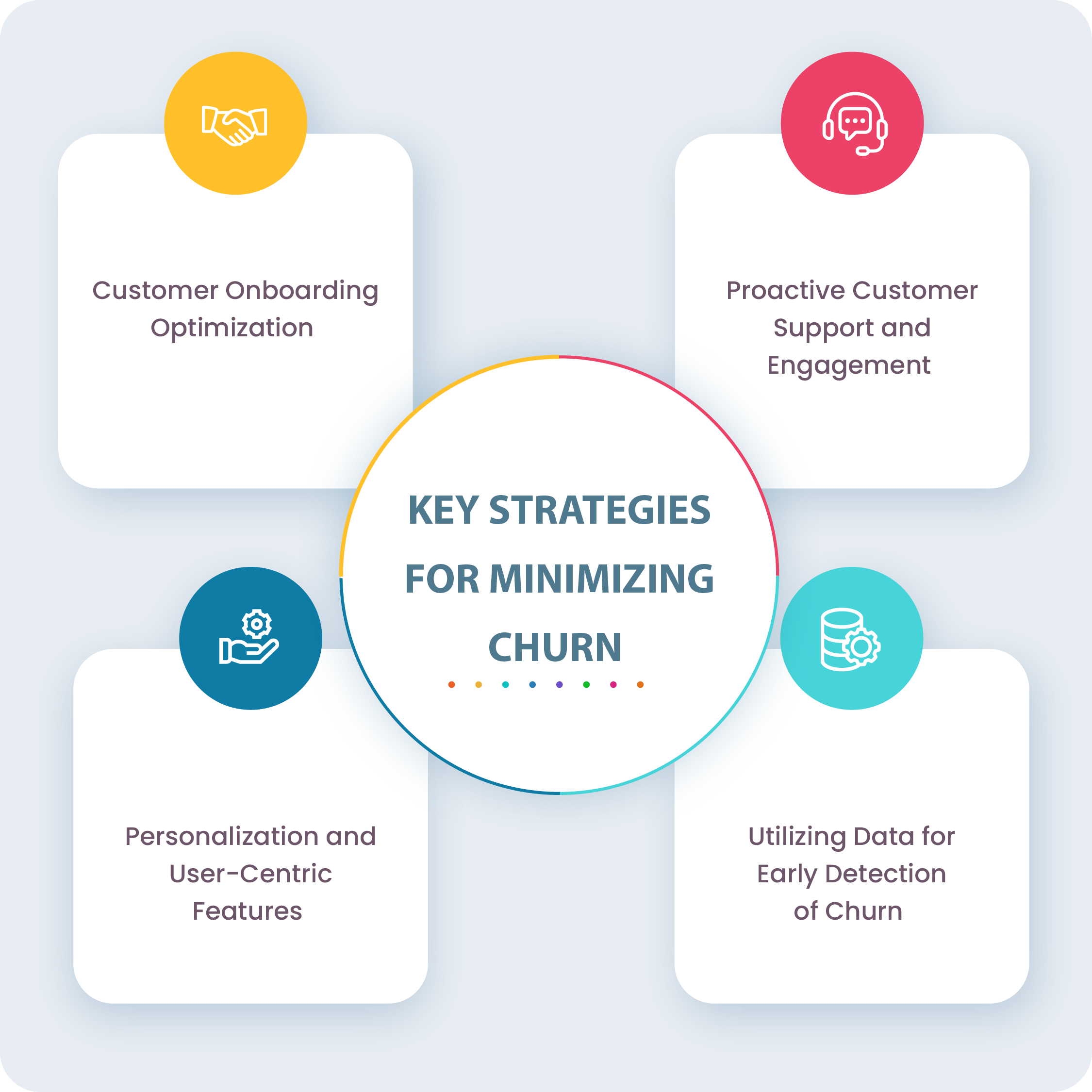
1. Customer Onboarding Optimization
A successful customer journey starts with an optimized onboarding experience. This is the first impression and sets the tone for the entire relationship. Best practices for onboarding include creating a structured, personalized program that addresses the customer's specific needs. Clear, step-by-step tutorials, video guides, and easy-to-navigate resources should be provided to ensure smooth adoption. Assigning a dedicated onboarding specialist or team can also help to guide customers through their first steps, answering questions and providing support. The goal is to make customers feel confident, informed, and empowered from the start, which builds a solid foundation for long-term engagement and success.
2. Proactive Customer Support and Engagement
To reduce churn, businesses must maintain consistent and proactive engagement with their customers. This involves regularly checking in with customers to ensure they are satisfied and achieving their desired outcomes with the product or service. Regular touchpoints, whether through email, in-app messages, or calls, help nurture relationships and keep customers informed about product updates, best practices, or new features. Providing resources, such as FAQs, self-service portals, or dedicated support teams, empowers customers to resolve issues quickly. The key is to be available and attentive, preventing dissatisfaction from escalating into churn.
3. Personalization and User-Centric Features
Tailoring the service to meet individual customer needs is essential for minimizing churn. By personalizing experiences, whether through customized product features, communications, or recommendations, businesses can ensure their offerings are directly aligned with customer goals. Using customer data and feedback to adapt the service and provide tailored solutions makes customers feel valued and understood. Additionally, ensuring that the product evolves alongside the customer’s growing needs, such as through modular features or scalable solutions, helps to retain customers long term by keeping the product relevant and useful as their business or personal needs change.
4. Utilizing Data for Early Detection of Churn
Data-driven decision-making plays a critical role in identifying early signs of churn. By analyzing customer behavior, engagement patterns, and usage trends, businesses can detect disengagement before it turns into full-blown churn. Monitoring key indicators, such as a decline in logins, feature usage, or customer service interactions, can alert businesses to potential issues. With predictive analytics, businesses can segment customers based on their risk of churn and take proactive measures to address concerns, offer additional support, or provide incentives to keep them engaged. By addressing potential problems early, businesses can prevent customers from leaving and instead nurture them back to satisfaction.
Maximizing Customer Value
1. Building Customer Loyalty Through Value-Added Services:
Exceed customer expectations by offering additional features, personalized support, and exclusive resources. Tailored recommendations, ongoing training, and premium tools enhance the customer experience. Proactive support through dedicated account managers or 24/7 help desks builds trust and loyalty, turning satisfied customers into advocates.
2. Creating a Strong Customer Success Program:
Establish a customer success team to guide customers, ensuring they derive maximum value from your product. Regular check-ins, tailored advice, and educational resources help customers achieve their goals. This boosts retention and satisfaction while identifying opportunities for upselling or product adoption, leading to long-term loyalty.
3. Upselling and Cross-Selling Opportunities:
Introduce upselling (upgrading to higher-tier plans) and cross-selling (offering complementary products) at the right moments to increase customer value. Tailor recommendations based on customer needs, offering more advanced features or add-ons to enhance their experience. This not only boosts revenue but also ensures the product remains indispensable to the customer’s evolving needs.
Successful Customer Retention Strategies with YoroCRM
YoroCRM employs a range of innovative and data-driven strategies to ensure long-term customer satisfaction and retention. By focusing on personalized experiences, proactive support, and continuous improvements, YoroCRM has positioned itself as a leader in customer retention. Below are key strategies and features that contribute to its success:
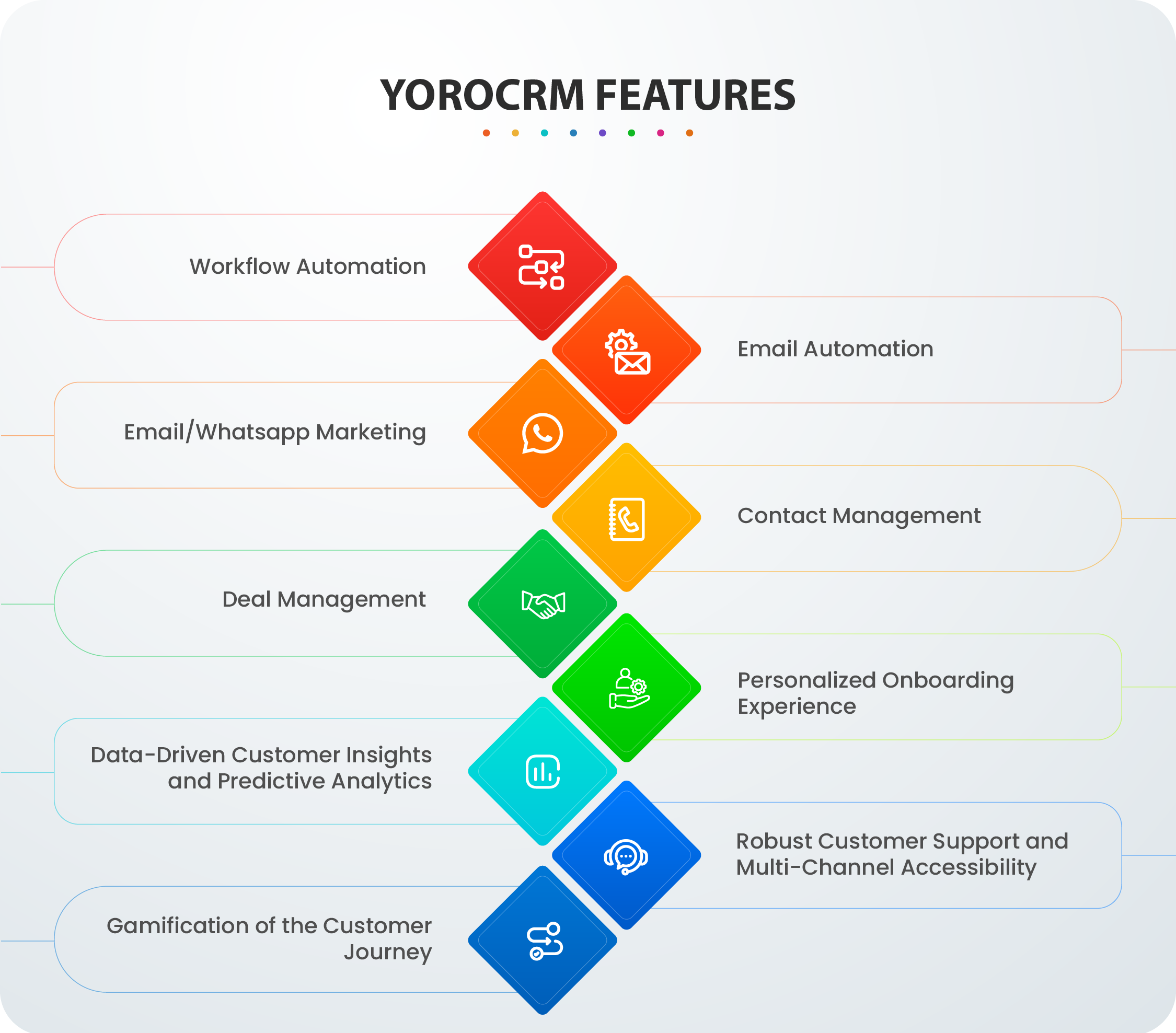
Workflow Automation
Strategy:
YoroCRM offers powerful workflow automation features that streamline repetitive tasks, saving time and ensuring consistency. By automating processes like lead capture, data entry, follow-ups, and task assignments, businesses can reduce human error and focus on more strategic efforts. The automation of workflows not only enhances productivity but also improves customer satisfaction by ensuring timely responses and actions.
Impact on Retention:
Automated workflows improve the customer experience by providing prompt responses, consistent communication, and reliable service. When customers experience a smooth, efficient process, they are more likely to remain loyal and continue their subscription.
Email Automation
Strategy:
YoroCRM’s email automation feature allows businesses to send personalized, timely emails to customers based on their behavior, preferences, and engagement levels. Whether it's sending welcome emails, nurturing leads, or offering product updates, automated emails ensure that customers stay informed without overwhelming the team.
Impact on Retention:
Timely and personalized emails help businesses stay engaged with customers at every stage of their journey. By providing relevant content and reminders, businesses can reinforce the value of the product and reduce the risk of churn.
Email/Whatsapp Marketing
Strategy:
YoroCRM integrates email and WhatsApp marketing, enabling businesses to reach their customers via multiple channels. This multichannel approach is particularly effective for sending promotional offers, important updates, and personalized recommendations. By leveraging these platforms, YoroCRM allows businesses to meet their customers where they are, ensuring higher engagement rates.
Impact on Retention:
Customers prefer to interact on their preferred communication channels, whether that’s email or WhatsApp. By offering multi-channel communication, businesses create a seamless experience, improving customer satisfaction and increasing the chances of long-term engagement.
Contact Management
Strategy:
YoroCRM’s contact management system allows businesses to store and categorize customer data in a centralized location, making it easy to track interactions, purchase history, preferences, and any ongoing issues. The CRM also helps segment contacts based on different criteria such as customer type, geography, or engagement level.
Impact on Retention:
Effective contact management ensures that businesses have a 360-degree view of each customer, enabling personalized communication and targeted outreach. By understanding customer needs and preferences, businesses can deliver better service, leading to higher retention rates.
Deal Management
Strategy:
YoroCRM’s deal management features provide sales teams with the tools to track opportunities, manage pipelines, and monitor the progress of deals in real time. The platform allows businesses to set reminders, track follow-ups, and prioritize high-value leads, ensuring that no opportunity is missed.
Impact on Retention:
By managing deals effectively, businesses can nurture relationships throughout the customer journey. Maintaining strong, consistent engagement during the sales process increases the likelihood of conversion and creates a foundation for ongoing retention through successful customer experiences.
Personalized Onboarding Experience
Strategy:
YoroCRM offers a highly personalized onboarding process that is tailored to the specific needs of each customer. The platform customizes onboarding workflows based on customer profiles, business goals, and use cases. Customers are guided step by step, with video tutorials, live demos, and tailored recommendations to ensure they make the most of the platform from day one.
Impact on Retention:
A personalized onboarding experience helps customers feel valued and confident in using the product. A well-executed onboarding process sets the tone for long-term success, encouraging customers to fully integrate YoroCRM into their daily workflows, thereby improving retention.
Data-Driven Customer Insights and Predictive Analytics
Strategy:
YoroCRM leverages predictive analytics to monitor customer behavior and track engagement patterns. By analyzing usage data, businesses can identify early signs of disengagement, such as reduced interaction with the platform or lower activity levels. YoroCRM’s analytics help identify customers who might be at risk of churning, allowing businesses to intervene before it’s too late.
Impact on Retention:
By leveraging data-driven insights, businesses can proactively engage at-risk customers with personalized outreach, support, or targeted promotions. Predictive analytics not only helps prevent churn but also enables businesses to optimize their strategies and provide better experiences, improving overall retention.
Robust Customer Support and Multi-Channel Accessibility
Strategy:
YoroCRM provides multi-channel support, offering customers a variety of ways to reach out for assistance, including live chat, email, phone support, and a comprehensive knowledge base. The platform also provides 24/7 access to customer support, ensuring that customers can resolve issues quickly and efficiently at any time.
Impact on Retention:
Customer retention heavily relies on how well a company handles support. By offering multi-channel accessibility, YoroCRM ensures that customers can reach help when they need it, reducing frustration and reinforcing trust. A reliable support system directly contributes to higher satisfaction and long-term loyalty.
Gamification of the Customer Journey
Strategy:
YoroCRM incorporates gamification into the customer journey by introducing milestones, achievements, and rewards for engagement. Customers earn points or badges for completing certain actions within the platform, such as using new features, reaching a certain level of activity, or completing training modules. This gamified approach adds an element of fun and achievement to the process, motivating customers to engage more deeply with the product.
Impact on Retention:
Gamification boosts engagement and makes the experience more interactive and enjoyable. When customers feel recognized for their efforts and progress, it strengthens their relationship with the brand, driving higher retention and reducing the likelihood of churn.
Building a Retention-Focused Culture
Creating a retention-focused culture is essential for long-term success. By aligning teams—sales, support, and product—around shared customer retention goals, businesses can deliver positive experiences that build trust and loyalty. Here’s how to develop a culture prioritizing retention:
1. Aligning Internal Teams with Retention Goals
Sales, support, and product teams must work together to ensure clear communication, shared objectives, and integrated processes. Sales should set realistic expectations, support should resolve issues quickly, and product teams should address customer pain points. This alignment enables teams to proactively anticipate needs, reduce churn, and improve customer loyalty.
2. Training Teams to Deliver Exceptional Customer Experiences
Invest in training programs to equip teams with the skills to handle customer interactions empathetically and effectively. Customer service reps should provide personalized support, sales teams should focus on long-term needs, and product teams should continuously improve the customer journey. Empowered employees lead to stronger relationships and higher retention.
3. Celebrating Retention Wins as Part of Company Culture
Recognizing achievements like successful onboarding or high customer satisfaction fosters motivation across teams. Company-wide celebrations, awards, and recognition build a sense of pride in retention goals and create a positive, customer-centric environment. Celebrating retention wins strengthens commitment to delivering exceptional service, boosting customer loyalty.
Measuring Success: KPIs and Retention Goals
To ensure that customer retention strategies are effective, businesses need to measure success through key performance indicators (KPIs) and set clear benchmarks and goals. By tracking these metrics, companies can assess how well their retention strategies are working, identify areas for improvement, and drive continuous growth.
Key Performance Indicators (KPIs) to Track Retention Strategies
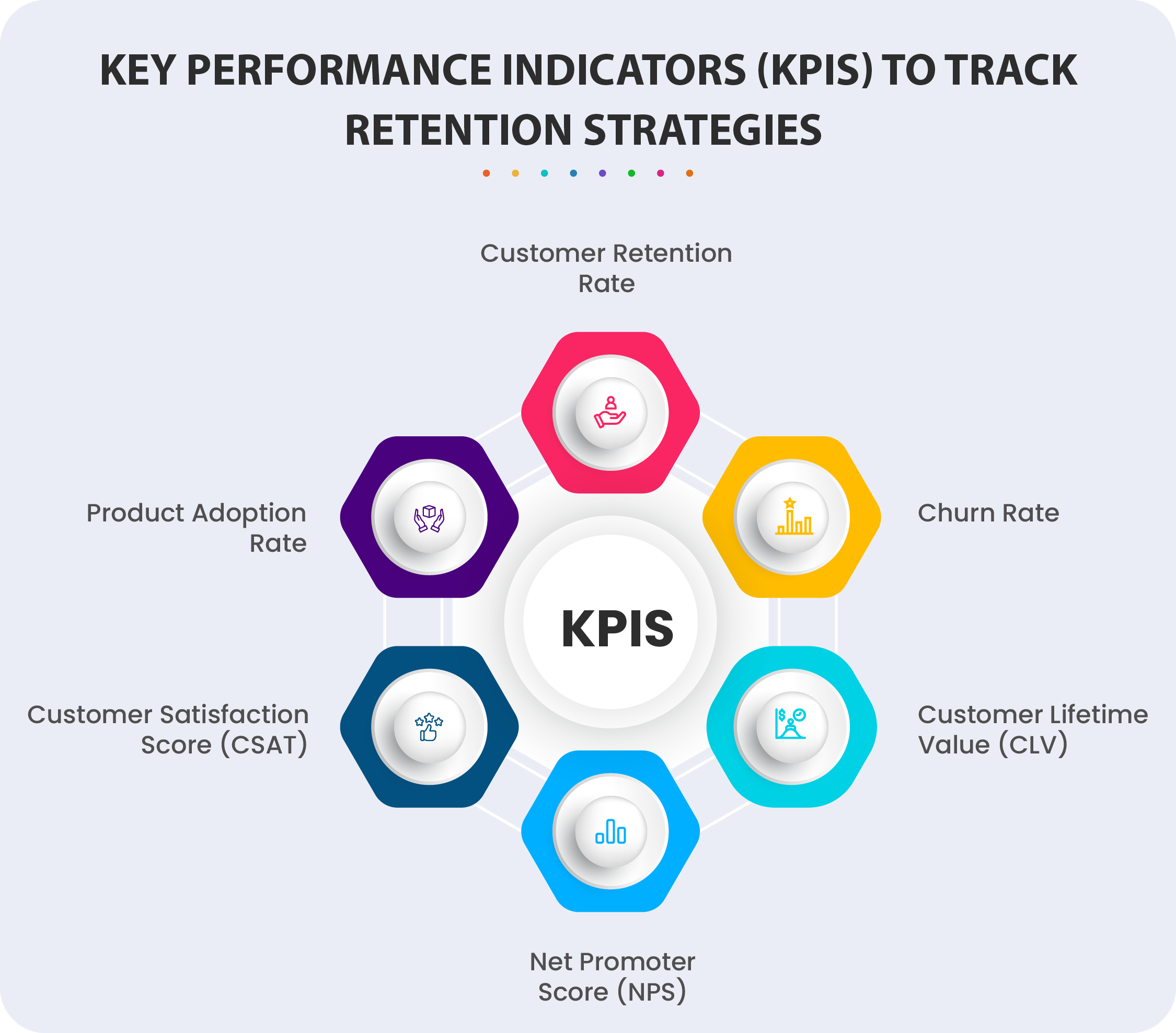
Tracking the right KPIs allows companies to assess the effectiveness of their customer retention initiatives. Some key retention-focused KPIs include:
- Customer Retention Rate (CRR): This is the percentage of customers a company retains over a specific period. It’s one of the most direct indicators of how well retention strategies are working. A high retention rate indicates that customers are satisfied and loyal.
- Churn Rate: The opposite of retention, churn rate measures the percentage of customers who stop using the product or service during a given period. A high churn rate signals that customers are leaving, prompting a review of retention efforts.
- Customer Lifetime Value (CLV): This metric tracks the total revenue a company expects to earn from a customer during their relationship. By understanding CLV, businesses can gauge the long-term value of retaining customers and tailor their efforts accordingly.
- Net Promoter Score (NPS): NPS measures customer loyalty by asking how likely customers are to recommend the product or service to others. A high NPS suggests that customers are not only loyal but also advocates for the brand, indicating strong retention.
- Customer Satisfaction Score (CSAT): This metric is based on customer feedback, usually after an interaction with customer support. A higher CSAT score reflects positive customer experiences, which are directly linked to retention.
- Product Adoption Rate: This measures how frequently customers are using the product’s features. A higher adoption rate indicates that customers are deriving value from the product, which correlates with longer-term retention.
Establishing Benchmarks and Setting Retention Goals

Establishing benchmarks and setting retention goals helps companies define what success looks like and provides a way to track progress. Here's how businesses can approach this:
- Analyze Historical Data: To set realistic benchmarks, businesses should look at their historical retention data. For example, if the average retention rate over the past year was 80%, a good benchmark might be to aim for a 5% increase in retention the following year. Historical trends can also reveal seasonal fluctuations or patterns in customer behavior.
- Industry Standards: Understanding industry benchmarks allows companies to compare their performance against competitors and the broader market. Industry research and reports can help set realistic and competitive goals based on what other companies are achieving.
- Segmented Goals: Retention goals should be segmented by customer types, product lines, or marketing channels to create more tailored and achievable targets. For example, setting specific goals for new customers, high-value customers, or long-term users can allow businesses to address their unique needs more effectively.
- Focus on Key Moments in the Customer Journey: Set retention goals at critical touchpoints in the customer lifecycle. These could include the first 30 days of product use (onboarding phase), customer re-engagement after a period of inactivity, or renewing subscriptions. Tracking retention progress at these key moments helps to pinpoint areas where interventions are most needed.
- Quarterly or Annual Retention Goals: Businesses should also set short-term (quarterly) and long-term (annual) retention goals. Quarterly goals allow for more frequent adjustments, while annual goals provide a larger target to drive the overall strategy.
- Incorporating Customer Feedback: Regular customer feedback should be incorporated into goal setting. If customers express dissatisfaction in surveys or through churn analytics, businesses can adjust their retention goals to address these issues and improve the customer experience.
Conclusion
Customer retention in the SaaS industry is an ongoing process that requires continuous investment and adaptation. Research shows that increasing customer retention by just 5% can boost profits by 25% to 95% (Harvard Business Review), highlighting the significant impact retention efforts can have on long-term profitability. As the SaaS landscape evolves, so do customer expectations, behaviors, and needs. The introduction of new technologies like AI and machine learning has reshaped how businesses engage with customers, creating a demand for more personalized and seamless experiences. With rising competition, SaaS companies must focus on not just retaining customers but also keeping them engaged to avoid churn. A 2023 report from ProfitWell revealed that SaaS churn rates average around 5-7% per month, showing how crucial it is for companies to stay ahead by continuously adapting their strategies.
For businesses like YoroCRM, the key to long-term success lies in viewing retention as a strategic priority. By continually improving customer satisfaction, offering value-added services, and ensuring proactive engagement, companies can foster lasting relationships. YoroCRM, with its features like automated workflows, data-driven insights, and personalized engagement tools, plays a pivotal role in supporting these retention strategies. By analyzing customer behavior, anticipating needs, and facilitating seamless communication, YoroCRM helps businesses optimize their retention efforts, adapting to market dynamics.
SaaS companies, including those leveraging YoroCRM, must implement a comprehensive retention strategy focused on customer success and satisfaction. Investing in personalized onboarding, robust support, proactive engagement, and data-driven insights is essential. By using YoroCRM’s full capabilities—workflow automation, customer journey tracking, and multi-channel communication—businesses can optimize retention efforts and meet customer needs effectively. Embracing a customer-centric approach and leveraging YoroCRM can build long-term loyalty, increase customer lifetime value (CLV), and position companies as leaders in an increasingly competitive market.